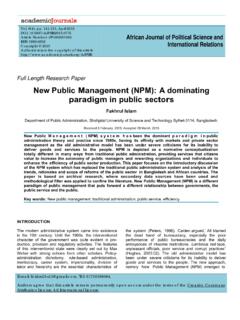Transcription of Standards of Practice for Case Management
1 CMSA Standards of Practice for Case Management 1 2016 2016 Foreword .. 2 Preface .. 3I. INTRODUCTION .. 5II. EVOLUTION OF THE Standards OF Practice FOR CASE MANANGMENT .. 8A. Standards of Practice for Case Management (1995) .. 8B. Standards of Practice for Case Management (2002) .. 8C. Standards of Practice for Case Management (2010) .. 9D. Standards of Practice for Case Management (2016) .. 9 III. DEFINITION OF CASE Management ..11IV. PHILOSOPHY AND GUIDING PRINCIPLES ..12A. Statement of Philosophy ..12B. Guiding Principles ..12V. CASE Management Practice SETTINGS ..14VI. PROFESSIONAL CASE Management ROLES AND RESPONSIBIILTIES ..15 VII. COMPONENTS OF THE CASE Management PROCESS ..181. Client Identification, Selection and Engagement in Professional Case Management ..182. Assessment and Opportunity Identification ..183. Development of the Case Management Plan of Care.
2 184. Implementation and Coordination of the Case Management Plan of Care ..195. Monitoring and Evaluation of the Case Management Plan of Closure of the Professional Case Management Services ..19 VIII. Standards OF PROFESSIONAL CASE Management Practice ..20A. Client Selection Process for Professional Case Management Services ..20B. Client Assessment ..20C. Care Needs and Opportunities Identification ..22D. Planning ..23E. Monitoring ..23F. O u t c o m e s ..24G. Closure of Professional Case Management Services ..24H. Facilitation, Coordination, and Collaboration ..25I. Qualifications for Professional Case Managers ..26J. Legal ..27 1. Confidentiality and Client Privacy ..27 2. Consent for Professional Case Management Services ..27K. Ethics ..28L. Advocacy ..28M. Cultural Competence ..29N. Resource Management and Stewardship ..29O. Professional Responsibilities and Scholarship.
3 30IX. GLOSSARY ..32 References ..37 Standards of Practice forCase Management REVISED 2016 2 CMSA Standards of Practice for Case ManagementForewordIt is my honor to present the 2016 revision of the Case Management Society of America s (CMSA) Standards of Practice for Case Management . CMSA, an interprofessional organization, remains dedicated to the support and development of case Management professionals. An outstanding hallmark of our profession is the willingness of its members to help one another learn and, thereby, improve the services that our profession performs. Unity is truly our strength. This fourth revision of our Standards of Practice came together with that same united commitment to excellence as seen within our profession. We recognized the need to revise the Standards of Practice in order to be reflective of the expanding role of the professional case manager.
4 The awareness that case managers are crucial members of the health care team has been realized providing the need to reexamine and redefine our role in the current complex health care tomography. The body of knowledge required to Practice case Management is rapidly growing as the specialty continues to evolve. Modern patient care must be based upon the holistic intertwining of information from a variety of disciplines. As our activities become more sophisticated, so must our resources which in turn must remain relevant. Professional case Management is neither linear nor a one-way exercise. Facilitation, coordination and collaboration occur throughout the client s health care encounter. Collaboration among physi-cians, nurses, case managers, social workers, pharmacists, allied health professionals, and support staff is critical in achieving the goals of the team, the organization and changing the way we deliver healthcare today.
5 Unity is our strength and this edition of the Standards of Practice , is the product of many hours of literature review, discussion, deliberation and collaboration among those who served on the taskforce (see page 31). It is this total body of work we are so proud to roll out. Before I close I would be remiss if a special thank you was not given to the key to our success, Cheri Lattimer, our Executive Director. Cheri worked tirelessly as our facilitator from beginning to end and through her support and guidance we were able to bring this project to fruition. We could not have completed it to this caliber without her leadership and for this we are grateful. Lastly I want to dedicate these Standards , to all of the professional case managers who make a difference every day in the lives of their clients. My dear late father knew firsthand what a case manager could accomplish and he would frequently ask What do people do without a Kathleen?
6 My hope is that in the not so distant future, such question will not need to be asked any longer because all people with complex conditions will have case managers who make their health care experience exponentially greater. Kathleen Fraser, MSN, MHA, RN-BC, CCM, CRRN President 2014-2016 CMSA Standards of Practice for Case Management 3 PrefaceThe Case Management Society of America (CMSA) first introduced the Standards of Practice for Case Management in 1995 and revised them in 2002 and 2010 thereafter. CMSA and its Board of Directors are pleased to offer the Standards of Practice for Case Management , 2016 revision, which provides Practice guidelines for the case Management industry and its diverse stakeholders. These Standards of Practice identify and address important foundational knowledge, skills, and competencies for the professional case manager within a spectrum of case Management Practice settings, specialties, and health and human service disciplines.
7 Similar to past revisions, the 2016 Standards reflect recent changes in the industry, which reso-nate with current Practice . Some of these changes include the following: Minimizing fragmentation in the health care system, application of evidence-based guidelines in Practice to promote collaborative care coordination, navigating transitions of care, and incorpo-rating adherence guidelines and other standardized Practice tools. Expanding and maximizing the contribution of the interprofessional collaborative health care team to planning care and services for individuals, improving the experience of those who are the recipients of professional case Management services, and ensuring safe, quality and cost-effective outcomes. We believe these are all important factors that professional case managers need to address in their Practice . The 2016 Standards of Practice contain information about case Management including an updated definition, Practice settings, roles and responsibilities, case Management process, philoso-phy and guiding principles, as well as the Standards and how they are demonstrated.
8 This document is intended for voluntary use. It is not intended to replace professional judgment or relevant legal, ethical or optimal Practice requirements. In all cases, case managers should consult their own compliance and legal advisors. CMSA provides these Standards of Practice as a resource to professional case managers and in no event shall CMSA be held liable for damages of any kind in connection with the material, methods, information, techniques, opinions, or procedures expressed, presented, or illustrated in these Standards of Practice even if CMSA has been information of the possibility of such liability. Our hope is that the Standards of Practice serve as a unifying force for professional case Management Practice by providing a common understanding and application of the role, process, and expectations. As such, the Standards serve to drive accountability for best Practice for individual professional case managers as well as for the organizations within which they work.
9 A dedicated team of expert and professional case managers spent countless hours in synthe-sizing relevant information from recent changes and developments in the industry. The 2016 revision of the Standards reflect what this team thought to be important for the professional Practice of case Management . The team included:1. A core task force made up of representatives of the case Management field from various prac-tice settings and professional A larger reference group that included the CMSA leadership and Board of Directors, legal advi-4 CMSA Standards of Practice for Case Managementsors, and the case Management Other case Management experts in the industry who acted in a peer review capacity. It has been our pleasure to work on this project with the talented and committed individuals who are raising the bar of excellence in the field of case Beth Newman, MSN, RN-BC, CCP, CCM, CHCQM, 2016 Taskforce Co-ChairKathleen Fraser, MSN, MHA, RN-BC, CCM, CRRN, 2016 Taskforce Co-ChairCMSA Standards of Practice for Case Management 5 I.
10 Introduction The consistent delivery of quality health and human services and the high financial costs generally associated with these services are important concerns that touch everyone, from our leaders in Washington, , to health care providers, and ultimately the American public at large. Payers today continue to seek innovative methods to reduce costs while advancing quality, safety, optimal care experience, and transparen-cy in outcomes of care. Providers explore inno-vative ways to define, impact, and report on the value of professional case Management services and their benefits to all stakeholders while max-imizing reimbursement. Too frequently however, the health care consumer is still left to wander a complex health care system without the neces-sary support, tools, resources, or knowledge to self-manage complex care needs in an effective, timely, and safe manner. All of these dynamics will continue to shape the context and effects of case Management .








